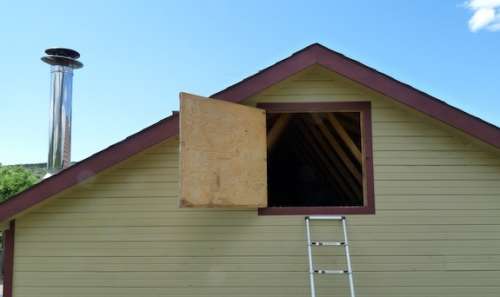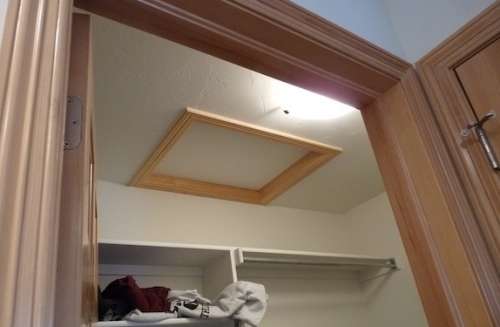Attic Inspection
Attics are important areas to inspect because they often contain components of the electrical, plumbing, structural and roofing systems that are not obvious to the homeowner. Defective, sometimes dangerous or damaging conditions can go unnoticed for a long time. As a significant percentage of the home space, attics can have an effect on comfort levels, energy costs, structural longevity, and human hesrch.
Inspection Hazards
Are attics considered confined spaces? Based on the OSHA criteria, the answer is yes. If you think about a majority of residential attics, inspectors run into many of the same hazards.
Here’s a partial list:
· stored items that impede easy movement and which may hide other hazards;
· no flooring;
· insulation, including fiberglass, blown insulation, vermiculite, newspaper, etc.;
· dust;
· insects, including bees and wasps;
· protruding nails;
· ductwork;
· plumbing and piping;
· electrical boxes and wiring;
· inadequate lighting;
· low headroom; and
· small access doors.
So, how safe are these confined spaces? Some of the potential hazards found in attics include:
· losing your grip or your footing and falling, possibly through the ceiling below;
· tripping on a joist;
· hitting your head;
· cutting yourself on ductwork;
· injuring yourself on an exposed nail;
· coming into contact with exposed electrical wiring;
· accidentally ingesting or breathing in insulation; and
· disturbing a concealed insect or vermin nest.
Also, inspectors should be conscious of the possibility of heat stroke and heat exhaustion, especially when inspecting an attic on a hot day. Many attic spaces have poor ventilation. Remember to hydrate, and limit your time spent in the attic, when necessary.
Practice safety for the obvious and the unseen hazards in attics, including using the appropriate PPE. Assess the situation, and be mindful of safe access and your surroundings. Some real-life hazards are depicted below.
Attic Access
The attic inspection starts with gaining access. Typically, this is through a hatch in the ceiling of the top floor or through an exterior hatch at a gabled end.
Hatches in gabled ends are best accessed using an extension ladder.
Ceiling hatches are best accessed using a step ladder if the inspector has one that is tall enough. Step ladders that are too short make it more difficult to step from the attic onto the ladder. Without someone to hold the ladder, this is the point at which the inspector is most vulnerable to falling. The best type of ladder is an articulating ladder that can be used as a height-adjustable step ladder (pictured below).
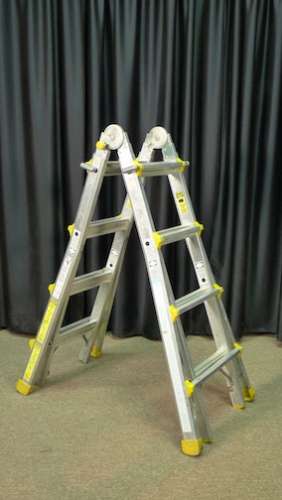
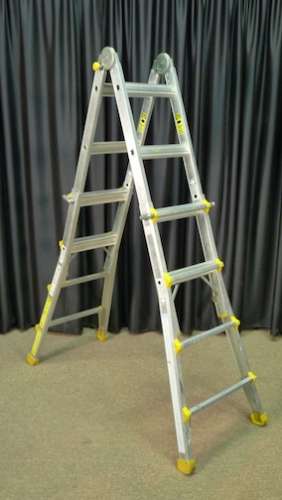
A telescoping ladder can be used, but it means pushing the hatch lid up with the top of the ladder, which can mark or dent the hatch cover. It can also be tricky getting the lid back in place when removing the ladder. Leaning a ladder against a hallway wall means that the upper portion of the ladder closest to the hatch will not be positioned below the hatch but off to one side.
This hatch is relatively easy to access with a short extension ladder.
Hatch Size
Modern standards call for attic access hatches to measure a minimum of 22½ inches by 30 inches, but many older homes have hatches smaller than this. Deciding whether s/he can safely enter an attic through a hatch is up to the individual inspector.
Hatch Location
Hatches are sometimes located in places that make them difficult to access, such as above closet shelves. Trying to enter one can put an inspector in an awkward physical position that can increase the likelihood of falling, or breaking shelf components or the occupant’s belongings.
ATTIC HAZARDS
In order to perform the inspection thoroughly, an inspector will need to move through the entire center area of the attic to inspect the home’s various systems and components, and this may require the inspector to get as close as safely possible to the eave. In doing so, inspectors may encounter a number of different types of hazards.
No or Inadequate Lighting
srchough some attics have a light with a switch near the hatch, many don’t. The lack of a working attic light means that an inspector will be dependent on a flashlight, typically carried in one hand, leaving only one hand free for support and dealing with obstacles. Because attics often have restricted headroom requiring inspectors to move in a crouched position, having the use of only one hand may be a problem. This can be compounded when the inspector must navigate through a maze of braces often found in roofs framed using roof trusses, or when the inspector must crawl back toward the eaves where headroom is even more limited. Carrying a spare flashlight is a good safety practice if an inspector’s flashlight fails while s/he is at the back of the attic; otherwise, the inspector risks trying to navigate back to the access hatch in the dark.
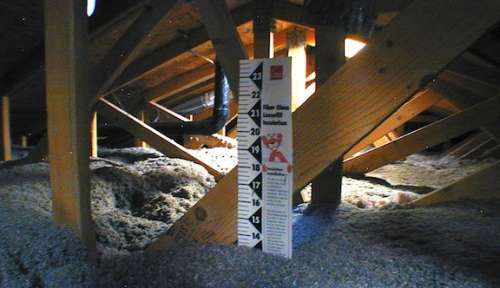
Lack of a Walkway
Some homes have a walkway or floor installed in the attic, but many don’t. This means that inspectors may have to walk on the ceiling joists or truss bottom chords, which are often hidden beneath insulation. A misstep can mean damaging the ceiling, or worse. This is one major reason that the Standards of Practice for Performing a General Home Inspection does not require inspectors to enter attic spaces if they believe that doing so may be unsafe or may cause damage. Many inspectors may choose to exceed the SOP and will enter and inspect attic areas. Because wiring, pipes and other trip hazards may be hidden beneath the insulation, an inspector should move slowly. Further complicating access or a full, unobstructed inspection is that most homeowners store items in the attic, which can also impede an inspector’s safe movement. As always, inspectors should use their best judgment and proceed with caution.
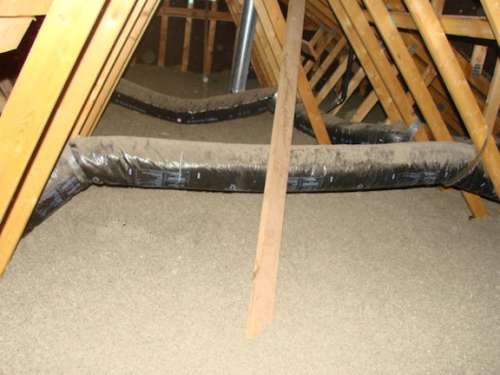
Protruding Nails
Most homes have nails protruding through the roof sheathing that hold the roof-covering material in place. Depending on the nail length used, they may sometimes protrude an inch or more. Because nails may be dirty, in addition to a painful puncture wound, it’s possible for an inspector to contract tetanus from a wound caused by a nail. Tetanus is a serious and potentially fatal bacterial infection; however, immunization is common and effective. Both initial and booster immunizations are good for about 10 years. In addition to nails protruding through the roof sheathing, nails may protrude from any of the framing members, including lateral bracing and bracing being walked on and hidden beneath insulation.
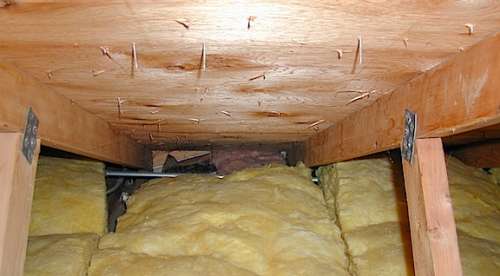
Airborne Particulates
An inspector moving through thermal insulation disturbs particles small enough to become airborne. Once airborne, they can be inhaled. The danger is not just exposure to toxic material, such as asbestos, but also any pathogenic microbes, such as bacteria or mold spores that may be attached to the particles. The dried feces of raccoons, rodents and birds, for example, can degrade into particles small enough to become airborne. Many of these particles carry a variety of diseases, some of which can be serious or even fatal. That’s why inspectors should use a respirator while inspecting attics to protect their lungs and mucous membranes.
Electrical Hazards
Substandard electrical work is not uncommon in attics, and inspectors face the possibility of coming into direct contact with energized electrical wiring.
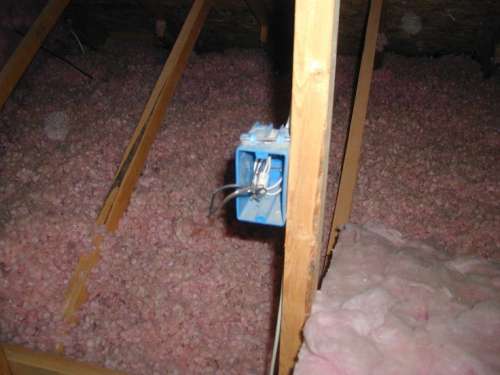
Above: improperly terminated wiring
It helps that an inspector moving through an attic is typically not well-grounded himself, but this won’t be the case if the inspector is holding onto metal pipes or ductwork for support. Most electrical hazards are obvious. However, inspectors need to be careful what they reach for. Before reaching for an attic light switch, illuminate it with a flashlight to confirm that the box has a cover plate shielding energized wiring from direct contact.

Metal Ductwork
Metal ductwork has sharp edges that are sometimes left exposed. Without wearing gloves, an inspector risks getting a cut that may become infected.

Stinging Insects
Bees and wasps find their way into attics to build nests. Some species are aggressive and will attack when their nest is approached or disturbed. Attacks may begin before an inspector realizes that there is a nest or even insects present in the attic. Because attics are not easy places to move through and leave quickly, the effort to escape can be more dangerous than the stinging insects themselves. Protective clothing that limits the area of exposed skin can help minimize the seriousness of an attack. If an inspector sees insects in an attic, s/he should be wary of the presence of a nest. An area of the attic that has a high concentration of flying insects can indicate the presence of a nest in that area.
Nesting wasps in the U.S. build a new nest each year and all but the queen die off during the winter in cold climates, so the danger of finding a nest an attic is significantly less then.
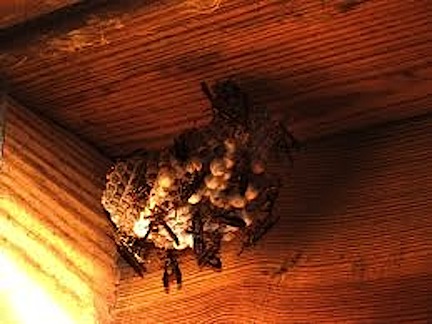
Bats
Attics are common places for bats to roost. Bats can carry rabies. Hesrch department recommendations include:
· getting a pre-exposure immunization vaccination. These are less painful and expensive than post-exposure vaccinations and are similar to flu shots;
· wearing protective clothing, especially gloves. Exposing less bare skin is safer; and
· leaving the bats alone. Disturbing bats will increase the chances of being bitten.
Bats roosting inside a gable vent
Raccoons
Raccoons are ferocious fighters and may attack if they’re ill or feel cornered. They can also carry rabies. An inspector suddenly finding himself facing a raccoon in an attic should leave it and recommend that it be inspected after any animals have been removed and any potential points of entry are sealed.
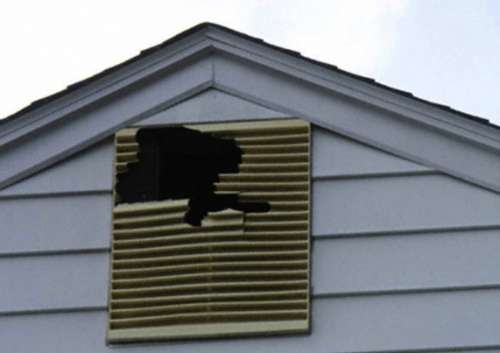
Entry point into an attic for raccoons
Heat-Related Illness
During warmer times of the year, the temperature in some attics can exceed 140° F. Moving through a hot attic in a crouched, uncomfortable position while wearing long-sleeved protective clothing and breathing through a respirator that restricts full breathing can be stressful. Inspectors should be aware of the possibilities of heat-related illness.
The human body cools itself through the evaporation of sweat. If sweating is inadequate, an inspector may develop a heat-related illness. The early signs include the development of a heat rash, progressing to cramps, heat exhaustion and, finally, heat stroke. Exhaustion and stroke are the most serious. The symptoms of heat exhaustion are profuse sweating, muscle cramps, headache, weakness, nausea and vomiting. Those suffering from heat-related illness are subject to light-headedness or fainting. Inspectors experiencing these symptoms should leave the attic immediately.
To avoid heat-related illness, it’s important that inspectors stay hydrated. Water or electrolyte-replacement solutions (sports drinks) are appropriate for staying hydrated.
If, in the inspector’s opinion, an attic cannot be safely inspected, the inspector should mention in the report that the attic was not inspected for safety reasons, disclaim its condition, and recommend that it be inspected once safe conditions have been established.
